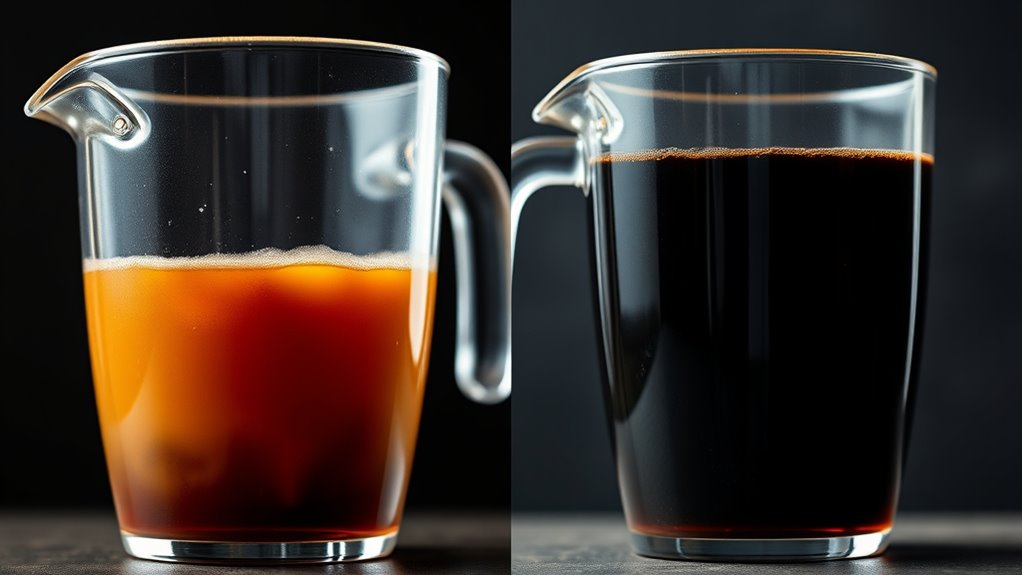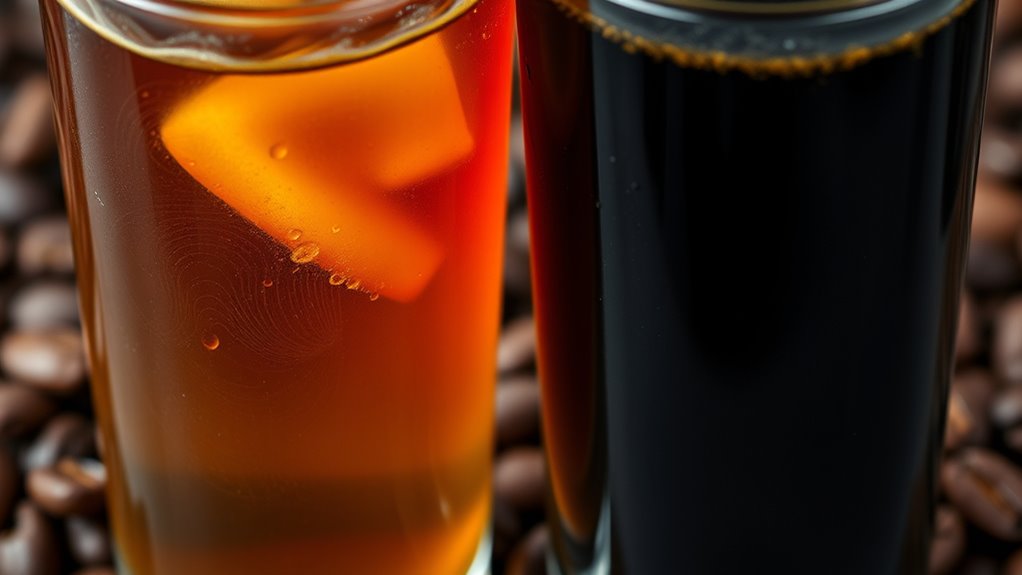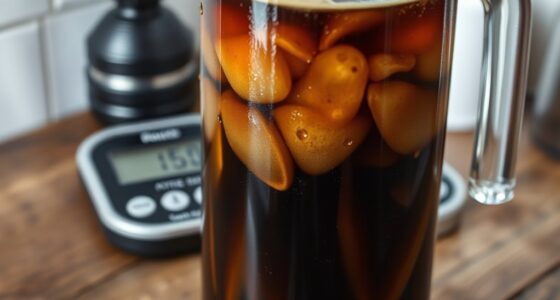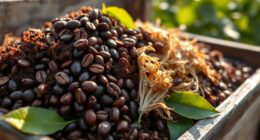When choosing between light and dark roast beans for cold brew, your flavor preferences will guide you. Light roasts deliver bright, nuanced, and acidic notes that highlight the beans’ original qualities. Dark roasts create a bolder, smoother, and more bitter profile, emphasizing richness and boldness. The brewing process and extraction methods can also influence the flavor. To discover how each roast changes your cold brew experience, keep exploring the details behind these differences.
Key Takeaways
- Light roast cold brew highlights bright, nuanced, and acidic flavors, emphasizing the beans’ original characteristics.
- Dark roast cold brew offers a bolder, smoother, and more bitter flavor profile due to its roasting process.
- Brewing time and grind size impact flavor extraction differently for light and dark roasts in cold brew.
- Light roasts may require longer steeping to develop their delicate flavors, while dark roasts are more forgiving.
- Flavor intensity in cold brew depends on roast choice, brewing method, and steeping duration.

When it comes to cold brew coffee, the choice between light roast and dark roast can substantially influence the flavor profile you experience. Your decision impacts not only the taste but also how the coffee interacts with brewing techniques and caffeine content. Light roasts are typically brewed using techniques that highlight their bright, nuanced flavors. They tend to preserve more of the beans’ original characteristics, resulting in a more vibrant and acidic cup. On the other hand, dark roasts are usually brewed to emphasize robustness and boldness, often with a smoother, more bitter profile. Understanding how your roasting choice interacts with brewing methods can help you craft the perfect cold brew to suit your preferences.
In terms of brewing techniques, light roasts often benefit from longer extraction times and slightly higher grind coarseness to maximize their delicate flavors. Since they contain more of the beans’ original aroma and complexity, a gentle, precise process allows you to extract their subtle notes without overpowering the palate. Dark roasts, however, are more forgiving and can be brewed with a coarser grind, thanks to their stronger, more pronounced flavors. They tend to be less sensitive to slight variations in brewing parameters, making them easier to prepare consistently. The method you choose influences how well the flavors develop during cold brewing, so experimenting with different techniques can help you find the sweet spot for your preferred roast.
Caffeine content is another essential factor that varies between light and dark roasts. While many assume dark roasts have more caffeine because they’re roasted longer, it’s actually the opposite. Light roasts generally contain slightly more caffeine by weight because the roasting process reduces caffeine content minimally compared to the beans’ original state. If you’re seeking a caffeine kick, a light roast cold brew might deliver a bit more punch. However, because dark roasts often have a bolder taste, some people find they need less coffee to feel satisfied. The brewing process also influences caffeine extraction; longer steeping times can increase caffeine levels regardless of roast. Ultimately, your choice depends on your caffeine needs and flavor preferences, but knowing this distinction can help you customize your cold brew experience.
Frequently Asked Questions
How Does Bean Origin Influence Cold Brew Flavor?
You’ll notice that bean origin greatly influences cold brew flavor. Different regions produce beans with unique flavor nuances—South American beans often have bright, fruity notes, while African beans bring vibrant, floral qualities. Central American beans tend to be well-balanced with hints of caramel. By choosing beans from specific origins, you can craft a cold brew that highlights these distinctive flavor nuances, making your brew personalized and flavorful.
Can Roast Level Affect Cold Brew Caffeine Content?
You might notice that a light roast often has slightly more caffeine than a dark roast because of how caffeine extraction works. In cold brew, the longer steeping process pulls out caffeine more evenly, but darker roasts with bolder flavor profiles can sometimes seem less caffeinated. For example, a study found that light roasts retain more caffeine after extraction, highlighting how roast level can influence your caffeine kick in cold brew.
Is Light or Dark Roast Better for Cold Brew Longevity?
You’ll find that dark roast is better for cold brew longevity because it maintains a richer flavor complexity over time, even as it ages. Plus, dark roasts often have higher roast sustainability, meaning they’re more resilient and less prone to flavor loss. If you want your cold brew to stay flavorful longer, go for dark roast; it’s designed to endure storage while preserving its bold, deep taste.
How Does Grind Size Vary Between Light and Dark Roasts?
Imagine a blacksmith forging a sword—your grind size varies by roast. You’ll find that light roasts typically require a slightly coarser grind for ideal extraction, while dark roasts benefit from a medium to coarse grind. Maintaining grind consistency is key, as particle size impacts flavor extraction. For cold brew, aim for uniform particle size, ensuring your brewing process is smooth, just like a well-forged blade.
Do Roasting Techniques Impact Cold Brew Flavor Profiles?
Roasting techniques markedly impact cold brew flavor profiles by influencing flavor extraction and aroma preservation. When you use a light roast, you preserve more delicate aromas and subtle flavors, resulting in a brighter, more nuanced cold brew. Conversely, dark roasts develop deeper, bolder flavors with richer aroma retention. Your choice of roasting method shapes whether your cold brew is vibrant and complex or smooth and robust, enhancing your overall coffee experience.
Conclusion
Ultimately, choosing between light and dark roast in your cold brew is like selecting the crown jewel of your coffee kingdom. Light roasts offer a delicate, vibrant symphony of flavors that dance on your palate, while dark roasts deliver an intense, bold punch that commands attention. Whichever you pick, remember—you’re crafting a beverage that can elevate your entire day to legendary status. So, go ahead, indulge in your roast of choice and make every sip an epic experience.









